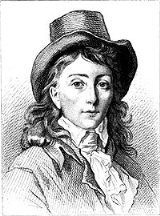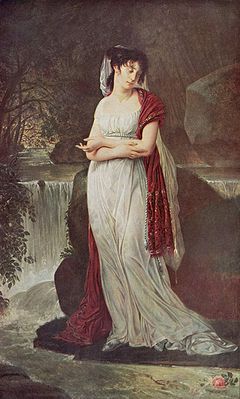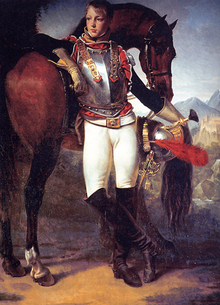
Antoine-Jean Gros
Encyclopedia

History painting
History painting is a genre in painting defined by subject matter rather than an artistic style, depicting a moment in a narrative story, rather than a static subject such as a portrait...
and neoclassical
Neoclassicism
Neoclassicism is the name given to Western movements in the decorative and visual arts, literature, theatre, music, and architecture that draw inspiration from the "classical" art and culture of Ancient Greece or Ancient Rome...
painter
Painting
Painting is the practice of applying paint, pigment, color or other medium to a surface . The application of the medium is commonly applied to the base with a brush but other objects can be used. In art, the term painting describes both the act and the result of the action. However, painting is...
.
Early life and training
Born in ParisParis
Paris is the capital and largest city in France, situated on the river Seine, in northern France, at the heart of the Île-de-France region...
, Gros began to learn to draw at the age of six from his father, who was a miniature painter, and showed himself as a gifted artist. Towards the close of 1785 Gros, by his own choice, entered the studio of Jacques-Louis David
Jacques-Louis David
Jacques-Louis David was an influential French painter in the Neoclassical style, considered to be the preeminent painter of the era...
, which he frequented assiduously, continuing at the same time to follow the classes of the Collège Mazarin.

French Revolution
The French Revolution , sometimes distinguished as the 'Great French Revolution' , was a period of radical social and political upheaval in France and Europe. The absolute monarchy that had ruled France for centuries collapsed in three years...
, threw Gros, in 1791, upon his own resources. He now devoted himself wholly to his profession, and competed (unsuccessfully) in 1792 for the grand prix. About this time, however, on the recommendation of the École des Beaux Arts, he was employed on the execution of portraits of the members of the National Convention
National Convention
During the French Revolution, the National Convention or Convention, in France, comprised the constitutional and legislative assembly which sat from 20 September 1792 to 26 October 1795 . It held executive power in France during the first years of the French First Republic...
, and disturbed by the development of the Revolution, Gros left France in 1793 for Italy.
Genoa and Bonaparte
He supported himself at GenoaGenoa
Genoa |Ligurian]] Zena ; Latin and, archaically, English Genua) is a city and an important seaport in northern Italy, the capital of the Province of Genoa and of the region of Liguria....
by the same means, producing a great quantity of miniatures and fixes. He visited Florence
Florence
Florence is the capital city of the Italian region of Tuscany and of the province of Florence. It is the most populous city in Tuscany, with approximately 370,000 inhabitants, expanding to over 1.5 million in the metropolitan area....
, but returning to Genoa where he made the acquaintance of Joséphine de Beauharnais
Joséphine de Beauharnais
Joséphine de Beauharnais was the first wife of Napoléon Bonaparte, and thus the first Empress of the French. Her first husband Alexandre de Beauharnais had been guillotined during the Reign of Terror, and she had been imprisoned in the Carmes prison until her release five days after Alexandre's...
. He followed her to Milan
Milan
Milan is the second-largest city in Italy and the capital city of the region of Lombardy and of the province of Milan. The city proper has a population of about 1.3 million, while its urban area, roughly coinciding with its administrative province and the bordering Province of Monza and Brianza ,...
, where he was well received by her husband, Napoleon Bonaparte.
On 15 November 1796, Gros was present with the army near Arcola when Bonaparte planted the French tricolor
Flag of France
The national flag of France is a tricolour featuring three vertical bands coloured royal blue , white, and red...
on the bridge. Gros seized on this incident, and showed by his treatment of it (entitled Bonaparte at the pont d'Arcole
Bonaparte at the pont d'Arcole
Bonaparte at the Pont d’Arcole is a 1796 painting by Antoine-Jean Gros, showing an episode during the battle of the pont d'Arcole, with general Bonaparte leading his troops to storm the bridge.- Description :...
) that he had found his vocation. Bonaparte at once gave him the post of inspecteur aux revues, which enabled him to follow the army, and in 1797 nominated him on the commission charged to select the spoils which should enrich the Louvre
Louvre
The Musée du Louvre – in English, the Louvre Museum or simply the Louvre – is one of the world's largest museums, the most visited art museum in the world and a historic monument. A central landmark of Paris, it is located on the Right Bank of the Seine in the 1st arrondissement...
.
Paris
In 1799, having escaped from the besieged city of Genoa, Gros made his way to Paris, and in the beginning of 1801 took up his quarters in the Capucins. His esquisse of the Battle of Nazareth (now in the Musée de Nantes) gained the prize offered in 1802 by the consulsFrench Consulate
The Consulate was the government of France between the fall of the Directory in the coup of 18 Brumaire in 1799 until the start of the Napoleonic Empire in 1804...
, but was not carried out, owing it is said to the jealousy of Jean-Andoche Junot
Jean-Andoche Junot
Jean-Andoche Junot, 1st Duke of Abrantès was a French general during the Revolutionary and Napoleonic Wars.-Early life:...
felt by Napoleon; but he indemnified Gros by commissioning him to paint his own visit to the pest-house of Jaffa
Jaffa
Jaffa is an ancient port city believed to be one of the oldest in the world. Jaffa was incorporated with Tel Aviv creating the city of Tel Aviv-Yafo, Israel. Jaffa is famous for its association with the biblical story of the prophet Jonah.-Etymology:...
. Les Pestiférés de Jaffa (Louvre) was followed by The Battle of Aboukir, 1806
Battle of Abukir (1799)
The Battle of Abukir was Napoleon Bonaparte's decisive victory over Seid Mustafa Pasha's Ottoman army on 25 July 1799 during the French invasion of Egypt...
(Versailles), and The Battle of Eylau, 1808
Battle of Eylau
The Battle of Eylau or Battle of Preussisch-Eylau, 7 and 8 February 1807, was a bloody and inconclusive battle between Napoléon's Grande Armée and a Russian Empire army under Levin August, Count von Bennigsen near the town of Preußisch Eylau in East Prussia. Late in the battle, the Russians...
(Louvre). According to the article about Gros in the Encyclopædia Britannica, Eleventh Edition, 1911, these three subjects – the popular leader facing the pestilence unmoved, challenging the splendid instant of victory, heart-sick with the bitter cost of a hard-won field – gave Gros his chief title to fame.
Britannica further remarks that as long as the military element remained bound up with French national life, Gros received from it a fresh and energetic inspiration which carried him to the very heart of the events which he depicted; but as the army, and its general separated from the people, Gros, called on to illustrate episodes representative only of the fulfilment of personal ambition, ceased to find the nourishment necessary to his genius, and the defect of his artistic position became evident. Trained in the sect of the Classicists, he was shackled by their rules, even when by his naturalistic treatment of types, and appeal to picturesque effect in color and tone he seemed to run counter to them.
Salon


Bonaparte Visiting the Plague-Victims of Jaffa
Bonaparte Visits the Plague Stricken in Jaffa is an 1804 painting commissioned by Napoleon Bonaparte from Antoine-Jean Gros to portray an event during the Egyptian Campaign...
. The painting launched his career as a successful painter. It depicts Bonaparte in Jaffa visiting soldiers infected with the bubonic plague. He is portrayed reaching out to one of the sick, unfazed by the illness. In reality, Bonaparte ordered the soldiers poisoned to either avoid returning or give up his soldiers to the Turks. It is even said he burned the pesthouse in order to cover up what he had done. The painting was commissioned as damage control when word spread of his actions. The painting is in the Neo-Classical style, though it shows elements such as the lighting and taste for the exotic are precursors to the upcoming Romantic ideals.
In 1810, his "Madrid" and "Napoleon at the Pyramids" (Versailles) show that his star had deserted him. His Francis I
Francis I of France
Francis I was King of France from 1515 until his death. During his reign, huge cultural changes took place in France and he has been called France's original Renaissance monarch...
and Charles V
Charles V, Holy Roman Emperor
Charles V was ruler of the Holy Roman Empire from 1519 and, as Charles I, of the Spanish Empire from 1516 until his voluntary retirement and abdication in favor of his younger brother Ferdinand I and his son Philip II in 1556.As...
, 1812 (Louvre), had considerable success; but the decoration of the dome of St. Genevieve (begun in 1811 and completed in 1824) is the only work of Gros's later years which shows his early force and vigour, as well as his skill. The "Departure of Louis XVIII
Louis XVIII of France
Louis XVIII , known as "the Unavoidable", was King of France and of Navarre from 1814 to 1824, omitting the Hundred Days in 1815...
." (Versailles), the Embarkation of Madame d'Angoulême (Bordeaux), the plafond of the Egyptian room in the Louvre, and finally his Hercules and Diomedes, exhibited in 1835, testify only that Gros's efforts—in accordance with the frequent counsels of his old master David – to stem the rising tide of Romanticism
Romanticism
Romanticism was an artistic, literary and intellectual movement that originated in the second half of the 18th century in Europe, and gained strength in reaction to the Industrial Revolution...
only damaged his once brilliant reputation.
Death
Again citing Britannica, "Exasperated by criticism and the consciousness of failure, Gros sought refuge in the grosser pleasures of life." On 25 June 1835 he was found drowned on the shores of the SeineSeine
The Seine is a -long river and an important commercial waterway within the Paris Basin in the north of France. It rises at Saint-Seine near Dijon in northeastern France in the Langres plateau, flowing through Paris and into the English Channel at Le Havre . It is navigable by ocean-going vessels...
at Meudon
Meudon
Meudon is a municipality in the southwestern suburbs of Paris, France. It is in the département of Hauts-de-Seine. It is located from the center of Paris.-Geography:...
, near Sèvres
Sèvres
Sèvres is a commune in the southwestern suburbs of Paris, France. It is located from the centre of Paris.The town is known for its porcelain manufacture, the Manufacture nationale de Sèvres, making the famous Sèvres porcelain, as well as being the location of the International Bureau of Weights...
. From a paper which he had placed in his hat it became known that "tired of life, and betrayed by last faculties which rendered it bearable, he had resolved to end it."
Renown
Gros was decorated and named baron of the empire by Napoleon, after the Salon of 1808, at which he had exhibited the Battle of Eylau.The number of Gros's pupils was very great, and was considerably augmented when, in 1815, David quit Paris and gave over his own classes to him. Under the Restoration
Bourbon Restoration
The Bourbon Restoration is the name given to the period following the successive events of the French Revolution , the end of the First Republic , and then the forcible end of the First French Empire under Napoleon – when a coalition of European powers restored by arms the monarchy to the...
he became a member of the Institute, professor at the École des Beaux Arts, and was named chevalier of the Order of Saint Michael
Order of Saint Michael
The Order of Saint Michael was a French chivalric order, founded by Louis XI of France in 1469, in competitive response to the Burgundian Order of the Golden Fleece founded by Philip the Good, duke of Burgundy, Louis' chief competitor for the allegiance of the great houses of France, the Dukes of...
.
M. Delcluze gives a brief notice of his life in Louis David et son temps ("Louis David and his Times"), and Julius Meyer's Geschichte der modernen französischen Malerei ("History of Modern French Painting") contains what Britannica cites as an excellent criticism on his works.

